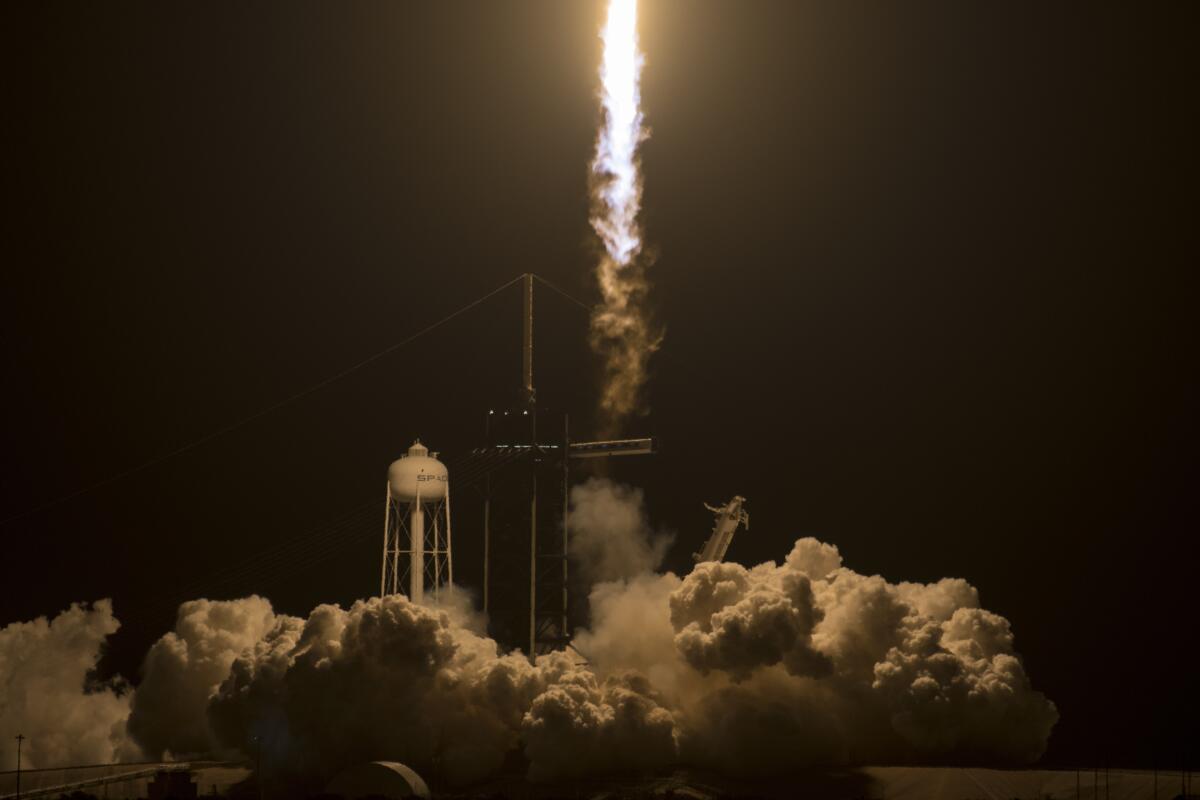Rocket used to carry astronauts fails on uncrewed satellite mission

- Share via
SpaceX’s workhorse Falcon 9 rocket, which carries astronauts to the International Space Station, experienced a rare failure Thursday night after blasting off from Vandenberg Space Force Base on an uncrewed mission.
The rocket, which had a payload of 20 satellites for SpaceX’s Starlink internet network, took off without incident about 7:30 p.m. Pacific time, but the second stage of the rocket that delivers the satellites into their final orbit failed.
SpaceX said the failure resulted in the satellites reaching a lower orbit than intended. SpaceX CEO Elon Musk tweeted Thursday evening that after engineers attempted to restart it, the second stage experienced an “RUD,” an acronym for “rapid unscheduled disassembly,” typically shorthand for an explosion.
On Friday, SpaceX said in an update said that a liquid oxygen leak had developed in the second stage of the rocket, but it survived the unsuccessful restart, though the satellites’ orbit is too low for them to remain in space.
The failure prompted the Federal Aviation Administration to ground the rocket pending the outcome of an investigation into the cause of the accident. SpaceX said it will conduct a full investigation in coordination with the agency.
Laura Forczyk, executive director of space industry consultancy Astralytical, noted that satellites were not destroyed when the rocket’s second stage failed.
If this had been a flight carrying SpaceX’s Crew Dragon capsule, she said, it would not necessarily have been catastrophic since the capsule could return to Earth using its parachute system.
The 20 satellites are expected to burn up in the atmosphere and not pose any threat, SpaceX said Friday.
The rocket has launched SpaceX’s Crew Dragon capsule with astronauts aboard to the space station more than a half dozen times since 2020. It was scheduled to launch another crew in August.
In all, the Falcon 9, which has a reusable first stage, has launched a total 352 missions, according to SpaceX. The company said the first stage used in Thursday’s night launch returned to Earth safely. Prior to Thursday’s launch, the Falcon 9 had not failed in more than 300 flights.
The rocket last failed in flight in June 2015 when it was carrying out an uncrewed cargo resupply mission to the space station. A Falcon 9 also exploded on the launchpad at Cape Canaveral Air Force Station in September 2016 during fueling while carrying a satellite payload.
A lengthy grounding of the rocket would deal a blow to the U.S. space and global satellite industries, which rely on the rocket to launch satellites not only for SpaceX but other customers.
SpaceX said Friday that “With a robust satellite and rocket production capability, and a high launch cadence, we’re positioned to rapidly recover and continue our pace as the world’s most active launch services provider.”
NASA has relied on the rocket and the Crew Dragon to ferry astronauts to the orbiting lab since awarding SpaceX a $2.6-billion contract in 2014 to develop the capsule.
The space agency awarded a larger $4.2-billion contract to Boeing to build its own capsule called the Starliner, but that program is years behind SpaceX and only launched its first human test flight last month.
That mission, repeatedly delayed on the launchpad, was supposed to last only eight days but now may be extended for months because of problems with the Starliner propulsion system.
There had been speculation that NASA might have to send a Crew Dragon to the station to bring the astronauts back down. The agency has denied that it has any such plans. But if the Starliner cannot be used, the Russians’ Soyuz craft could serve as an alternative.
The next human flight of the Falcon 9 rocket had been scheduled for July 31 at Cape Canaveral Space Force Station, when it was expected to launch billionaire Jared Isaacman to space in a private tourist flight.
That flight and the August mission to the space station are now in limbo.
More to Read
Inside the business of entertainment
The Wide Shot brings you news, analysis and insights on everything from streaming wars to production — and what it all means for the future.
You may occasionally receive promotional content from the Los Angeles Times.











